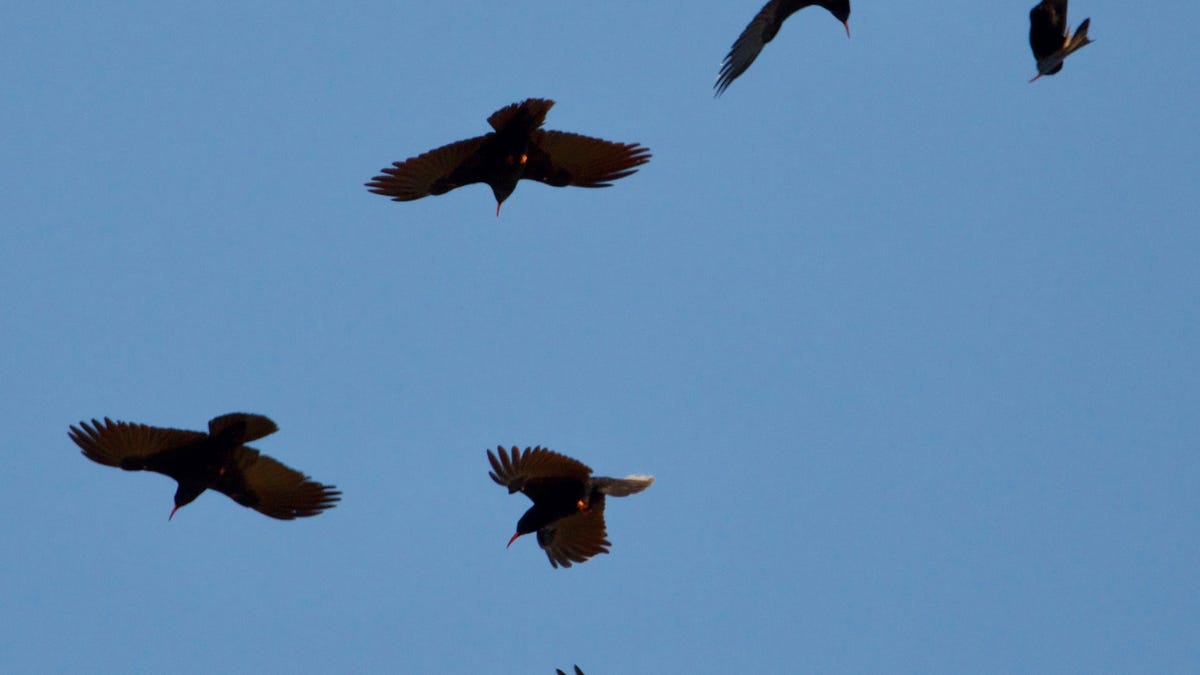Scientists catch more than 5,000 flying birds with their bare hands
They role-played as Neanderthals to learn how early humans grabbed dinner.

How could Neanderthals have caught choughs for dinner without specialized tools?
A hefty amount of fossil evidence suggests Neanderthals caught raven-like birds, or choughs, for dinner. But how could they capture flying animals without modern technology? To find out, scientists took matters into their own bare hands.
Using only the glimmer of a flashlight to represent the kind of torch Neanderthals would have wielded, Spanish researchers wandered into dark caves known to house these red-billed choughs and trapped the birds themselves.
Turns out, it's not that hard.
In fact, it's so doable that according to their research, published Sept. 15 in the journal Frontiers in Ecology and Evolution, the team caught 5,525 choughs with relative ease. This might explain why fossils of these birds are often found in Neanderthal caves with unusual cuts, as well as offer some intriguing clues into the lifestyle of the prehistoric humans.
"Winter after winter, summer after summer, we would go out in the field trapping these animals," said study author Juan J. Negro, an evolutionary ecologist at Estacion Biologica de Donana in Spain. "Sometimes we would get 200, [some] nights we were less lucky and there would be only 10 or 15."
Negro and fellow researchers discovered that as long as Neanderthals had a light source and engaged in teamwork, It's highly likely they caught the flying birds in preparation for an evening meal. Like the researchers themselves, the ancient humans wouldn't have needed any specialized tools or techniques.
That gives us some crucial information.
First, it suggests Neanderthals found a way to create and use fire to illuminate their environment -- otherwise, they wouldn't have been able to spot choughs in the caves. Because of the Neanderthal cooperation, the team also gleaned information on some of their social and cognitive abilities.
Group of choughs caught at night by the scientists, released afterward.
The general public typically tends to think of Neanderthals as unintelligent, chaotic and uncivilized, but scientists are slowly uncovering evidence that these early humans might have been more intelligent than suspected. One recent study found they were rather artistic and another suggests they shared cultural ideas with modern humans.
Further in line with overturning such presumptions, Negro and his team found while simulating a Neanderthal society that collaboration was key in containing the little birds.
"When we collaborate, it's super easy to trap them," he said. "When we go alone, they fly around and it is much more difficult -- so, we assume that they did the same, the Neanderthals."
If Neanderthals maintained a system of working together, then once upon a time, they may have had a much more advanced approach to communication and syncing up than previously thought.
Chough fossils with markings that suggest they'd been cooked and eaten.
Additionally, even though fossils of choughs have been found with markings suggesting they'd been cooked and eaten, the paleontology community has long been confused about when Neanderthals would've had an opportunity to catch them, if at all, Negro explains.
Choughs are known to spend their days away from their caves on the cliffs Neanderthals roamed, limiting the chances a hunter would find one to trap, Negro said. Paleontologists "were obsessed with the fact that choughs are super active during the day. They are inaccessible to humans -- even for us now."
A red-billed chough.
"They never thought about the night, when they become vulnerable."
According to the team, Neanderthals' chough captures could've actually happened from the comfort of their own caves, where the choughs are also thought to have resided, or roosted, at night.
"For years, paleontologists, they thought, 'Well, these birds, they live in caves the humans use for shelter' -- they never made the link'" that Neanderthals actually trapped and ate them, Negro explained.
Negro and team's hands-on study also could debunk the belief that modern technology was needed to capture other flying main courses, such as pigeons, which evidence suggests only appeared on the lunch menu.
That's because pigeons are highly prevalent in the daytime. As a New Yorker who walks through swarms of them during my morning commute, I can attest to that.
And if you were wondering, because the reenactment was in the name of science, and not the reality TV show Survivor, the researchers let the birds go. But they're now left with firsthand verification that Neanderthals' evenings may have consisted of hearty dinners where choughs were the main event.

